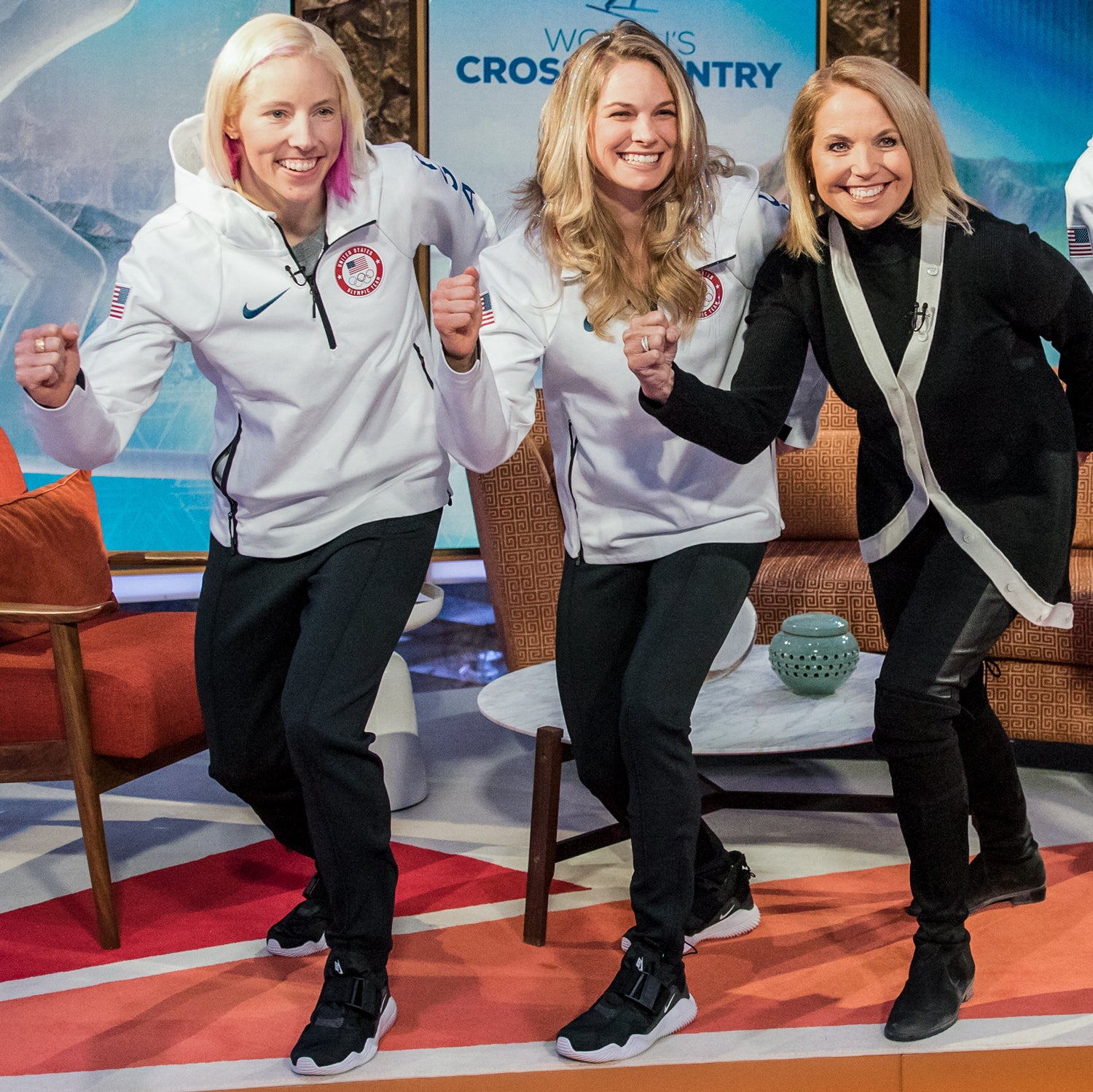For the past 2,000 years, nordic skiing hasn’t been particularly lighthearted. Paintings of the original Birkebeiner, the heroic Norse rebels from the 1100s, depict two bearded Vikings skiing through a storm with battle axes and swords drawn as they haul their young prince to safety. The warriors are grimacing; the toddler is grimacing; and every nordic ski racer since has grimaced, too. We once called it the hardest test of athletic endurance on earth.
Catch the starting line of a modern World Cup or Olympic nordic event and the Swedes grimace, the Russians grimace, and maybe one of six Norwegians in the front row will crack half a sardonic smile before catching themself and reverting to dour. Don’t blame them for this. This is the sport of Vikings, after all, and when Vikings vanquished their enemies, they would projectile vomit into… their… mouths.
But then the camera pans to the American superstar and multiple Pyeongchang gold-medal threat , who took fifth in the 10K freestyle on Thursday, her third event at the 2018 Olympics. Her face is streaked with neon pink war paint and an amazing amount of glitter, and she’s jumping up and down and bobbing her head from side to side. She’s also waving spastically at the camera and grinning infectiously and, unless your heart resides above Whoville, you cannot help but laugh with her.
Diggins has won three World Cups outright and stood on the podium of three more. She is also the pep maven of the the U.S. Women’s nordic squad—the happiest team on earth. But it wasn’t always this way. For most of the history of U.S. nordic ski racing on the international stage, the team had little to be peppy about. The Americans would often field only partial teams—and often without enough bodies to enter a four-person relay race. Other than Bill Koch, who won a silver medal in 1976, U.S nordic skiers standing on World Cup or Olympic podiums pretty much didn’t happen. We sucked and we knew it. So why smile?
The Swedes grimace, the Russians grimace, and maybe one of six Norwegians in the front row will crack half a sardonic smile before catching themself and reverting to dour.
Then, in 2005, a woman from Alaska with a superhero physique and pink streaks in her hair showed up on the European circuit and changed the dynamic. Kikkan Randall looked around and realized that none of her Scandinavian competitors expected anything of her, which made her believe that she could surprise them. “It started for me personally going into my first Olympics [in Torino in 2006],” Randall told me just before the start of the Pyeongchang Games. “We weren’t planning on winning medals, but I started to think that we could do this. It was such an elusive feeling. But when I got my first World Cup win, it was no longer a theory.”
Randall went on to earn three season titles, 13 World Cup victories, and stood on 29 podiums. She is unquestionably the best nordic racer the U.S. has ever produced. Still, it would take more than Randall’s individual success to create the happiest team in the world. Former Ski Racing editor Peggy Shin recounts what happened next in her new book, . The epiphany involved socks. Just prior to a 2012 World Cup, Randall, who was injured, bought four pair of wildly striped stockings for her teammates who would be competing without her in a relay. She thought it would make for some fun team building. Her young teammate Diggins applied the face paint and glitter. “As the U.S. Women warmed up for the relay,” Shin writes, “the other teams looked at them like they had lost their minds. Who were these clowns?”
The squad finished fifth, the best result by a U.S. nordic team in relay history. And every year since, the U.S. women have been podium contenders in nearly every international race they’ve entered. In Pyeongchang, Randall was a medal threat in two events in her fifth Olympic Games. (She finished 16th out of 90 racers in the 10K skate.) The team is rounded out with proven distance racer Liz Stephens, tested sprinter Sophie Caldwell, and two-time Olympians Ida Sargent and Sadie Bjornsen. Diggins now takes point on team spirit, helping with and applying sparkles and pink paint to unsuspecting roommates. Her goal is to bring the joy to the entire U.S. Ski and Snowboard Team, not just the women’s nordic crew. This fits with her high school nickname: Sparkle Chipmunk.
The U.S. nordic women’s sudden rise makes you wonder: Is happy faster than angry? Is there a strategy in giddiness? For Diggins, the answer is an enthusiastic—more accurately, irrepressibly enthusiastic—yes. “I’ve always been a really happy athlete,” she says. “That’s how I race fast. When I’m having a good time, that means I’m believing in myself and my team. I get out of my own way. I’m often dancing on the start line, because I’m here to have fun and go so, so hard. That’s where the sparkles come in. It’s a promise to myself that I’m going to give my all.”
For a scientific take, I turned to Gretchen Reynolds, who writes the for The New York Times. She pointed me toward two studies that show endurance benefits from and a in the form of an upbeat mantra. The studies imply that much of what we experience as fatigue might be initiated in the brain, and a smile and happy self-talk can short those circuits, letting you go harder longer. The key, though, is that you have to believe the positive self-talk. That and your smile should be intermittent and genuine. A death-mask grin doesn’t work.
On race day, Diggins eyes squirrel around in her head and her form goes to hell as she breaks at the waist and poles wildly. If it was humanly possible, she’d vomit up her lungs and employ them as sails to hold a lead.
Thing is though, as happy as the women’s nordic squad is before and after races (and every other minute of their apparently blissed-out existences—they make skiing for a living look fun) I’ve never seen any of them smile in an actual race. Nordic racing is simply too hard for that. No matter the distance, the final stretch of every race is an all-out effort. The skiers in podium contention are burning it past redline.
Who knows, maybe the smiling and self encouragement is the secret sauce. Or perhaps, as Shinn posits, it’s the teamwork thing. The 2004 Red Sox had that going on, too. But if you ask me, women just dig deeper. On race day, Diggins eyes squirrel around in her head and her form goes to hell as she breaks at the waist and poles wildly. If it was humanly possible she’d vomit up her lungs and employ them as sails to hold a lead. Joy awaits.
Can you see that same spirit in the women who are running for office and displacing misogynists? It’s such transcendence that captivates us. Watching the U.S. women’s nordic team go from glitter pixies to shield maidens and back is the antidote to the times.
Except they’re stronger than Vikings, they’re women nordic racers.


